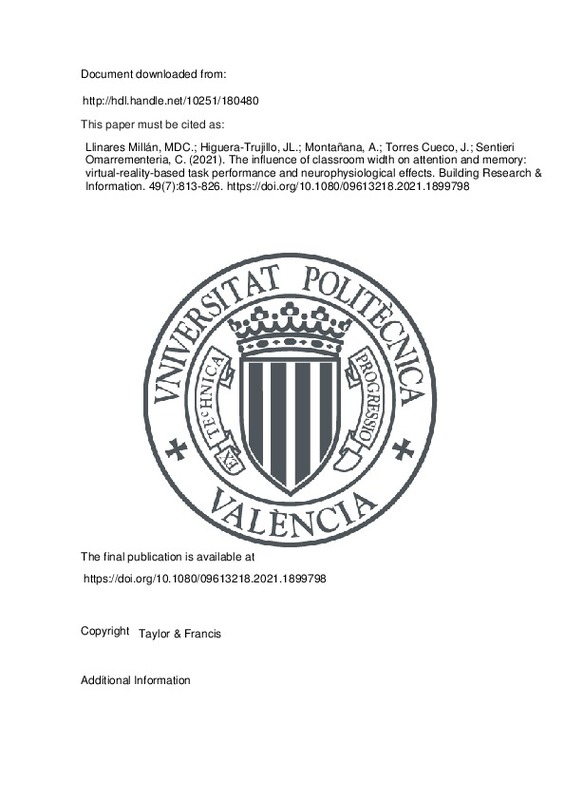JavaScript is disabled for your browser. Some features of this site may not work without it.
Buscar en RiuNet
Listar
Mi cuenta
Estadísticas
Ayuda RiuNet
Admin. UPV
The influence of classroom width on attention and memory: virtual-reality-based task performance and neurophysiological effects
Mostrar el registro sencillo del ítem
Ficheros en el ítem
| dc.contributor.author | Llinares Millán, María Del Carmen
|
es_ES |
| dc.contributor.author | Higuera-Trujillo, Juan Luis
|
es_ES |
| dc.contributor.author | Montañana, Antoni
|
es_ES |
| dc.contributor.author | Torres Cueco, Jorge
|
es_ES |
| dc.contributor.author | Sentieri Omarrementeria, Carla
|
es_ES |
| dc.date.accessioned | 2022-02-03T19:04:52Z | |
| dc.date.available | 2022-02-03T19:04:52Z | |
| dc.date.issued | 2021-10-03 | es_ES |
| dc.identifier.issn | 0961-3218 | es_ES |
| dc.identifier.uri | http://hdl.handle.net/10251/180480 | |
| dc.description.abstract | [EN] Classroom design influences the cognitive processes that determine learning. However, the effects of classroom geometry have been little studied, in part due to the difficulty of modifying physical spaces for experimental purposes. Today, virtual reality allows researchers to very closely control many environmental conditions while collecting psychological and neurophysiological metrics of the user experience. The objective of the present study is to analyse the influence of classroom width on the attention and memory performance of university students. The performance of 90 subjects in three classroom width settings (8.80, 8.20, and 7.60 m), implemented in virtual reality, was evaluated through measures of their attention- and memory-related psychological and neurophysiological responses. The results showed that wider classrooms are associated with poorer performance and lower emotional arousal. This demonstrates a link between the geometric variables of classrooms and the cognitive and physiological responses of students. In general, the present study and its methodology can help architects and researchers develop design guidelines that can improve students' cognitive processes. | es_ES |
| dc.description.sponsorship | This work was supported by the Ministerio de Economia, Industria y Competitividad of Spain [Project BIA201786157-R]. The second author is supported by funding from the Ministerio de Economia, Industria y Competitividad of Spain [PRE2018-084051] and the Academy of Neuroscience for Architecture [John Paul Eberhard ANFA Fellow]. | es_ES |
| dc.language | Inglés | es_ES |
| dc.publisher | Taylor & Francis | es_ES |
| dc.relation.ispartof | Building Research & Information | es_ES |
| dc.rights | Reconocimiento - No comercial (by-nc) | es_ES |
| dc.subject | Classroom design | es_ES |
| dc.subject | Attention | es_ES |
| dc.subject | Memory | es_ES |
| dc.subject | Neuroarchitecture | es_ES |
| dc.subject.classification | PROYECTOS ARQUITECTONICOS | es_ES |
| dc.subject.classification | ORGANIZACION DE EMPRESAS | es_ES |
| dc.title | The influence of classroom width on attention and memory: virtual-reality-based task performance and neurophysiological effects | es_ES |
| dc.type | Artículo | es_ES |
| dc.identifier.doi | 10.1080/09613218.2021.1899798 | es_ES |
| dc.relation.projectID | info:eu-repo/grantAgreement/AEI/Plan Estatal de Investigación Científica y Técnica y de Innovación 2013-2016/BIA2017-86157-R/ES/EL DISEÑO DEL AULA PARA POTENCIAR LOS PROCESOS COGNITIVOS DEL ALUMNADO: UNA PROPUESTA METODOLOGICA PARA EVALUAR LAS VARIABLES LUZ, COLOR Y FORMA/ | es_ES |
| dc.relation.projectID | info:eu-repo/grantAgreement/AEI//PRE2018-084051//AYUDA PARA CONTRATO PREDOCTORAL PARA LA FORMACION DE DOCTORES-HIGUERA TRUJILLO, JUAN. PROYECTO: EL DISEÑO DEL AULA PARA POTENCIAR LOS PROCESOS COGNITIVOS DEL ALUMNADO UNA PROPUESTA METODOLOGICA PARA EVALUAR LAS VARIABLES LUZ COLOR Y FORMA/ | es_ES |
| dc.rights.accessRights | Abierto | es_ES |
| dc.contributor.affiliation | Universitat Politècnica de València. Departamento de Proyectos Arquitectónicos - Departament de Projectes Arquitectònics | es_ES |
| dc.contributor.affiliation | Universitat Politècnica de València. Departamento de Organización de Empresas - Departament d'Organització d'Empreses | es_ES |
| dc.description.bibliographicCitation | Llinares Millán, MDC.; Higuera-Trujillo, JL.; Montañana, A.; Torres Cueco, J.; Sentieri Omarrementeria, C. (2021). The influence of classroom width on attention and memory: virtual-reality-based task performance and neurophysiological effects. Building Research & Information. 49(7):813-826. https://doi.org/10.1080/09613218.2021.1899798 | es_ES |
| dc.description.accrualMethod | S | es_ES |
| dc.relation.publisherversion | https://doi.org/10.1080/09613218.2021.1899798 | es_ES |
| dc.description.upvformatpinicio | 813 | es_ES |
| dc.description.upvformatpfin | 826 | es_ES |
| dc.type.version | info:eu-repo/semantics/publishedVersion | es_ES |
| dc.description.volume | 49 | es_ES |
| dc.description.issue | 7 | es_ES |
| dc.relation.pasarela | S\438100 | es_ES |
| dc.contributor.funder | Agencia Estatal de Investigación | es_ES |







![[Cerrado]](/themes/UPV/images/candado.png)

